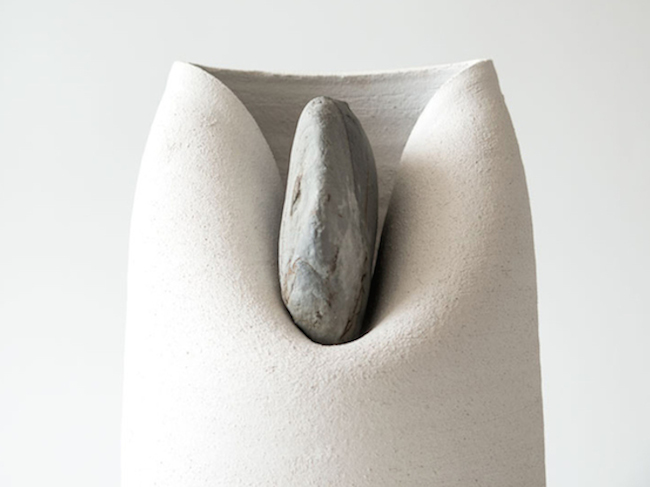Barcelona-based designer Martín Azúa utilizes “experimental methods” as a key part of his design philosophy. In addition to working with several companies, exhibiting at MOMA in New York and designing medals for the Swimming World Championship in Barcelona, he works in the studio finding ways to include natural processes in the functions of his designs as a way to “preserve cultural and technological diversity.”
Below are some of his ceramic designs that we’ve noticed recently. They’re in limited editions and numbered.
Above image: Martín Azúa, from the Vase with Stone series.

Vase with Stone by Martín Azúa.
Azúa’s Vase with Stone series was born while the designer was leaving vases in a river for his Natural Stain series, which we’re including later in this post. It’s a variation of Azúa’s experiments with natural processes in that latter work. In the case of Vase with Stone, the designer set rocks on the mouths of the vases while they were still unfired, allowing the stone to alter the vase’s shape.
The series is very porous and cannot hold water like a typical vase. They are meant as stand-alone decorative objects. The design was made in collaboration with Marc Vidal.


Vase with Stone

Kàntir by Martín Azúa.
Kàntir is Azúa’s take on the “botijo,” a vessel for drinking cold water. Produced in collaboration with Marc Vidal, the series is produced in winter and summer editions. The summer vessels cool water through natural properties of the clay that allow water to come into contact with air, making the liquid slightly cooler than room temperature.
The winter vessels include a glaze which holds the water at room temperature. These vessels also work as vases.

Kantir

Natural Stain by Martín Azúa.
Ceramics-making is a time consuming process, but that’s an understatement when it comes to Natural Stain. The porous white ceramic vases were left outside “in the middle of nowhere” for a year. During this time mosses and other organic processes left their own designs on the vessels.
The designer’s web site states of the project:
“Traditional decorative design manuals urged the artist-decorator to reproduce nature, not so much in order to imitate its appearance as to spot the hidden laws that would enable them to establish a new “sense of order”. But in Azua’s work the ‘bearing’ theme of decoration is grafted on to another element involved in the changing appearance of things: the patina of time.”
Any thoughts about this post? Share yours in the comment box below.



Natural Stain by Martín Azúa.

Martín Azúa

Add your valued opinion to this post.